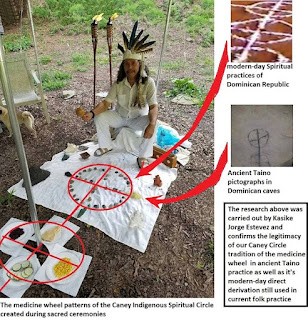They are used as a mouth or portal to accept feeding the Lwa. They are a portal through which forces can move, activated by the priest, their tools, and pwen/point/license/access given in initiation or through bloodline and given foundation. The closest english word I could come to is "attunement", alignment and agreement/oath. The spirits within African traditions are ancestors or ancestral spirits that followed a people, a tribe's culture and their land. Through joining a temple you are adopted into their lineage, along with any connections that you have which were somewhat broken (if you do not have an unbroken family line) and can be repaired. Usually temples are a gathering of families or run by family.
Veve and pwen are lineage, from lineages. A pwen also can be held by many things. Veve are passed down in the family and/or through temple lineages for the spirits that are served locally. The Lwa recognize these Veve as signatures, and recognize the priest because we also have these same spirits. My Veve belong to my lineage and I have never seen them publicly. They do have some similarity to other Veve of the same Lwa that other people have.
If you are using a Veve off the internet or in a book, you are approaching the Lwa through or tapping into someone else's lineage. The Lwa will also expect you to greet them a certain way with songs and the tcha tcha, shekere or asson received by priests or passed down by families. This will notify them of who you are children of if you are branched farther from same roots. It can be thought of as a calling card, signature, or telephone number. Some Veve are created for artistic and not spiritual purposes or value. If you do not use a lineage Veve properly, this may upset some Lwa, or they will not answer.
You also must be careful, a Veve for Dhamballah I saw on the internet was actually for his Petro version.
Some Lwa do not have Veve. Veve are not the only way we can work with Lwa, since the pwen, access is internal. Therefore we also have no absolute need of statues, representations and images. They help to manifest the energy of the Loases which flow internally through us in physical mediumship.
Veve were created in the new world, there were none in Africa. They probably created by Congo influence, indigenous Taino pictograms, and perhaps some European alchemist grimoires and sigils.
Taken from Miguel Sague, from Caney Circle
Public Veve for a type of Marassa Lwa: twins give rise to a third: triplets Petro or child born after
Some of the Veve for the drums also have a tri-medicine wheel motif
taken from palomontenegro
Technically as we salute the 4 directions, this is around the pillar in the temple as center.
Where spirit and matter interact.
Congo cosmogram, Palo firma/petipemba for the 4 winds and a Lucero. Lucero is the Mpungo similar to the Lwa Legba or the Orisha Ellegua. The cross symbol is prechristain across many cultures. To the Congolisa the cross symbolized Nzambi, God, as well as the earth/universe.
Public Veve for Public Legba
Masonic Symbol: square and compass
Public Ayizan Veve
Public Erzulie Freda Veve
The same symbol can be seen on other veve such as to the loases of various Oguns, Sobo Bade and Ghede & more
There is a Veve called Milokan (thousands/ mil of camps) which feeds or can call all the Lwa.
It is a mega Veve in which individual Veve can be seen together.
This is so no one is left out and has hurt feelings, it is more economical in terms of time, and it can be used to search a solution, or a persons spirits.
Veve can be drawn in several materials such as ground corn, and other substances I will not discuss and sometimes for specific Lwa. I have never seen certain substances we also use mentioned in public. There has been some others mentioned in public such as wood ash. brick dust, gunpowder and wheat flour. The substances used are depending on the purpose of ritual and the Lwa being called. They can be traced in the dirt or sand with a stick or informally they can also be drawn in chalk but not traditionally. They are made by bending at the waist and pouring the material, not by kneeling or sitting. They can be danced over, and are usually scrubbed or washed over after the ritual is over.
From Enchanting Scores
Veve have symbols that can be read, and contain usually the crossroads of Papa Legba, the Lwa spirit who for the most part, opens the way to the other rada Lwa. The veve also may contain other images such as tools, weapons, stars, points, crosses, and initials. There are points on the Veve on which certain items are placed such as plates of food, sacrificed animals in other lineages, candles and other things.
Different African tribes and people mixed in the new world to create different traditions and lineages, in Vodou we are predominately west African in spiritual heritage. Therefore we each have our own spirits, and ways of working with them. We do not use the firmas or petipembas from Palo which is Cuban and Congo based, nor do we use the ponto riscado as in Quimbanda in Brazil. Lucumi does have some symbols but they are also very different.
I hope this has helped your understanding of Vodou & Veve lineage!











Wow! Very informative and the remark on a particular Veve being a "signature" was enlightening! They're much more personal to me now and give them even more respect - they deserve it.
ReplyDeleteThankyou for your comment and readership
Delete